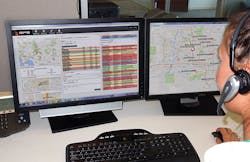A crowded field drives fleet software companies closer to their users
CHICAGO — Telematics companies, particularly those offering GPS-based fleet management solutions, have become the victims of their own success. Almost everyone who uses a fleet has experienced the efficiencies fleet management systems can bring to their business. As more and more companies have adopted the technology the competition has turned fierce.
“The problem with this space is right now everyone loves this reoccurring revenue model,” Ryan Driscol, marketing director for GPS Insight said. “At some point every fleet is going to have GPS tracking. It’s the way it’s going to be. It’s the only way to manage your fleet and actually control your costs and stay competitive. So a ton of companies have come into this space and now we have more competition than ever.”
As different companies work to differentiate themselves, more and more are turning to the user experience. “There are a lot of companies out there that make promises that they can’t keep,” Driscol said, “just to get you to sign and then figure it out later. And it just doesn’t happen. By then the contractor is locked into a platform and they won’t be getting that integration they were hoping for.”
That integration, working seamlessly with the rest of a company’s business software, has been a key part of improving the user experience. GPS Insight has made a recent push to build relationships with other software vendors that make it easier to push data from it’s software to different applications; to send location data, geofencing data, and to integrate with CRM (Customer Relationship Management) software.
Mobile technology drives future of service, customer satisfaction
“We can also take data and pull it into our software,” Driscol said. “Onto maps, for example. We can do map overlays that can pinpoint business-specific points of interest.”
NexTraq is also stressing integration. It’s become a necessity as even smaller fleet operations have become more sophisticated. “We’re finding that the smaller fleets are almost as demanding as [the larger ones],” Wyn Partington, vice president of Product and Marketing for NexTraq said. “The owners of the businesses we deal with are younger now, the next generation down, and they’re not so technologically-averse.”
In response to the many, many back-end solutions on the market, NexTraq has developed an extremely robust, extremely open API (Application Program Interface) that the user can adapt to suit their needs.
“So if you have an IT team or have access to developers, you can basically re-write the NexTraq app using the API,” Partington said. “We took our 170 page API document and said go forth, do what you want with it.”
Another arrow in NexTraq’s user experience quiver has been education. The more familiarity the customer has with the application the fewer frustrations they will experience when using it, and the happier everyone is with the overall experience.
So NexTraq has Pre-sales teams that make contact with potential customers and post-sales teams to follow up after a sale. “We do on-demand web training,” Partington said, “we host various web sessions and, if you need something specific, we’ll develop training along with you.”
And like GPS Insight, NexTraq has made follow-through on its promises to its customers paramount. To that end, NexTraq has been trying to leverage its history as one of the oldest companies in the business, and it’s size as one of the largest.
“A lot of the companies that come around offer a cheap plug-and-play product,” Partington said, “but you have no idea what they’re going to be doing in three years time. We’ve been around. Our parent companies are valued at $15 billion. We’re not going anywhere.”
Telogis has decided to partner with the company that practically defined the user experience as it applies to software: Apple. A suite of enhancements to their vehicle and mobile workforce apps will take advantage of unique tools and features available on the iPhone, iPad and Apple Watch.
Telogis is actively trying to make telematics fun for its customers. One of the company’s apps, Telogis Coach, invites users into a friendly competition by scoring users’ driving behaviors through various safety or productivity metrics. Drivers can even be identified and recognized for doing well and setting good examples.
“Working directly with Apple to build extraordinary user experiences into apps like Telogis Coach brings our customers a level of ease, familiarity and functionality that makes work on an [Apple platform] more productive and more fun,” said David Cozzens, CEO at Telogis.
But for every company in the telematics business, nothing can take the place of a dependable customer service team, whether that means a person to chat with online, a person to call on the phone, or someone to actually come out in person.
“We are going to work our hardest to make sure that we are actually solving that contractor’s business challenges, whatever they may be,” Driscol said. “It’s not them coming to us and saying, ‘Hey, we need a feature, can you make it?’ It’s them saying, ‘This is our problem, how can your software help us?’”
About the Author
Steve Spaulding
Editor-in-Chief - CONTRACTOR
Steve Spaulding is Editor-in-Chief for CONTRACTOR Magazine. He has been with the magazine since 1996, and has contributed to Radiant Living, NATE Magazine, and other Endeavor Media properties.

